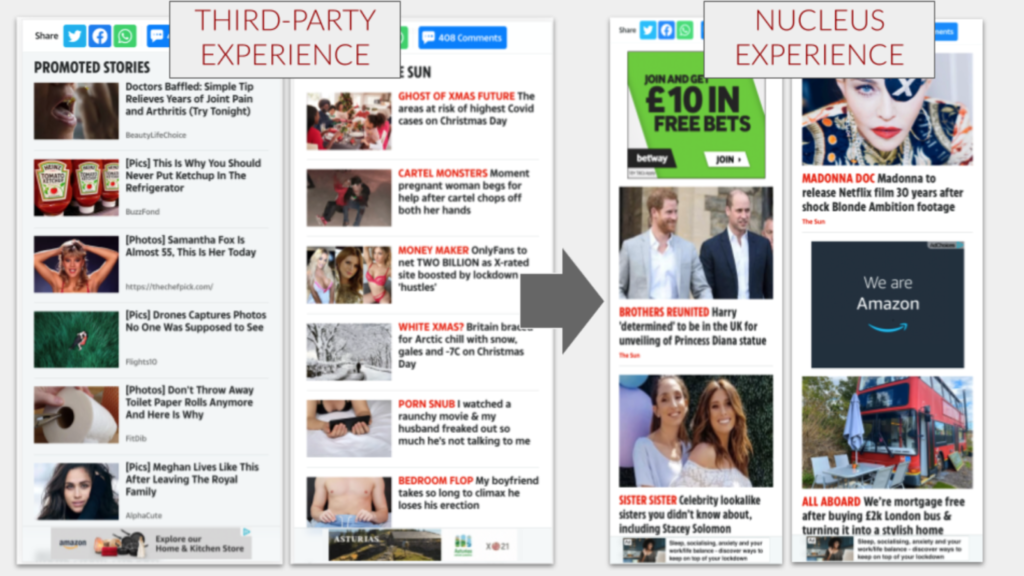How do you increase article clicks while driving more ad views and creating a cleaner experience for readers?
The answer is in the humble hyperlink and, here at News UK, we just won another award for building our own link recommendation engine.
ExchangeWire’s The Wires gave the “Best New Product or Service: Sell Side” award to Nucleus Personalisation, technology we built to help readers discover editorial and sponsored content in the optimum way. And that was just the latest of several such awards. So, what did we do?
Understanding behaviour
Links are the lifeblood of the web. Like many other publishers, The Sun has long added extra story links to the bottom and side of article pages, pointing both to external advertorials and to further stories from The Sun.
Historically, we have worked with a number of third-party content-discovery technology partners to deliver these links, and they have been valuable partnerships.
But the experience provided was not always on-brand. In fact, rather than encouraging consumers to engage more deeply, we noticed clutter from excess and off-topic recommendations was often driving them away from our sites.
The secret sauce
We knew we wanted to provide a cleaner experience for our readers, more clicks for our ad partners and more traffic for our editorial.
Recent advances in our data capabilities around our own audience helped us realise we could do just that. In 2021, we launched Nucleus, our first-party data platform with data on our 36.5 million digital readers, listeners and viewers available to ad buyers.
Because we now know so much more about our audience than third-party vendors do, we figured we could serve more personalised content recommendations, allowing us to limit excess placements and increase the likelihood of a click. That is why we set about building our own content recommendation engine.
Do it yourself
To develop Nucleus Personalisation, we combined three in-house capabilities:
- Our own ad technology stack, built for serving targeted programmatic display and native advertising.
- Our new Commercial Data Mart, providing granular data on advertising performance to give us insight on the optimum number of ads and in which positions to serve them.
- New content recommendation models built by our Data Science team, using data on our consumers’ on-site behaviour and their reading history to personalise the recommended article lists to sit alongside the ads.
This was one of the largest cross-functional teams we’ve ever put together, cutting across both business and technology departments.
Our teams collaborated for a year on implementing, experimenting and optimising Nucleus Personalisation before full roll-out.
We had to test and validate our assumptions at every step to ensure we could match or exceed our current user experience and revenue.
One of the biggest cross-collaboration projects that @NewsUK has seen significantly increased @TheSun online’s revenue and click-thru’s. Thanks and credit to our Dir. of Data, Tom Jackson and his ace team. https://t.co/x5PqeTFfEI #newsuktech #data #collabration #awards2022
— News UK Technology (@NewsUKTech) January 27, 2022
New approach

After finding pleasing results in testing during early 2021, we removed the third-party solution from the site in July 2021, and have been relying on Nucleus Personalisation ever since.
What users now see is a fully-controlled multi-tiled unit appearing at the bottom of an article, as well as in other placements throughout the page.
Each tile can represent a suggested article, or an ad. Crucially, each tile can function autonomously, meaning that different combinations of articles and ads are possible to optimise the user experience.
It includes fewer, larger tiles; less clutter; better quality ads, and more editorial control on which articles feature within it.
Recommendation results
The results have been great.
- We have generated 40% more clicks on recommended articles than the third-party tech averaged in 2020.
- Whereas recommended content delivered by third parties tends to use outlandish graphics and stories to stand out, our use of personalisation allowed us to avoid jarring attempts at capturing audience attention. This aligns recommendation units more natively with our content, and allows us to present fewer, larger units overall.
- That fresh canvas has been good news for advertisers. Ad revenues from recommendation units are up 220% on average versus those generated by the third party in the same period of 2020. During Black Friday 2021, that was as much as 360%.
In short, this initiative has been a resounding success, enabling us to achieve all of our objectives and take back control of article recommendations on our site – something which, at the start of the project, we were not sure was possible.
What’s next
To me, Nucleus Personalisation represents what it means to offer not only a “customer-first” product but an “experience-led” one.
A better overall experience creates a unique competitive advantage that is more difficult to replicate.
We have already begun phase two of the roll-out, including more varied user interaction options within the tool. This includes:
- Ecommerce articles during Black Friday.
- Newsletter sign up widgets.
Results for this have been incredibly encouraging. For instance, we have been able to match the Average Revenue Per User (ARPU) of ecommerce articles recommended using our first-party data and audience segmentation, versus the high-intent audience traffic that comes direct from SEO.
The options for testing and learning within these units are endless and allow us to dramatically expand the number of “next interactions” our users can make once they have read an article.
It has been a win-win-win with higher ad yields, more engaged readers and a new AI capability News UK cannot wait to roll out further.